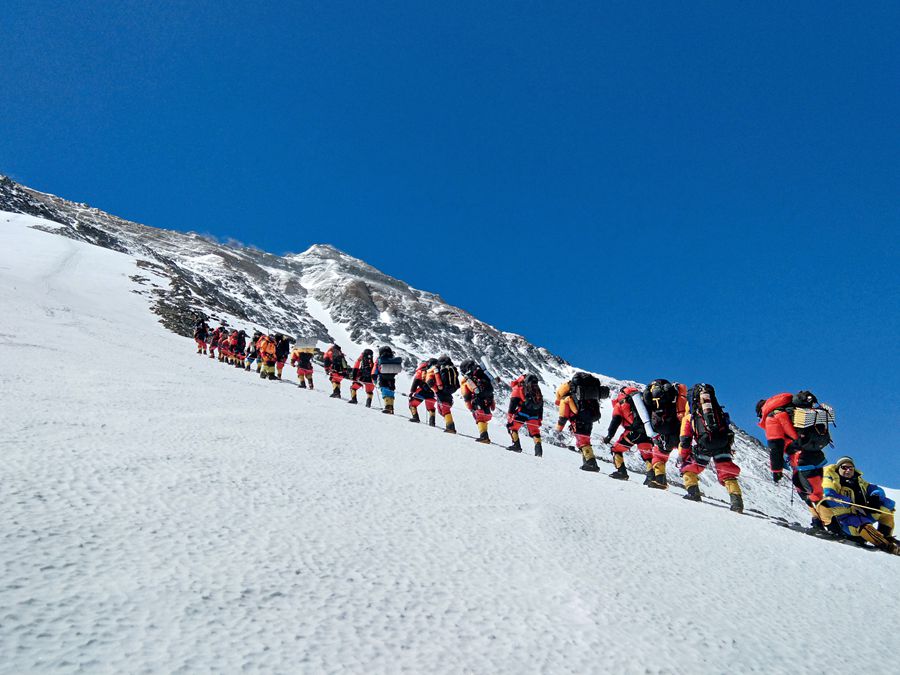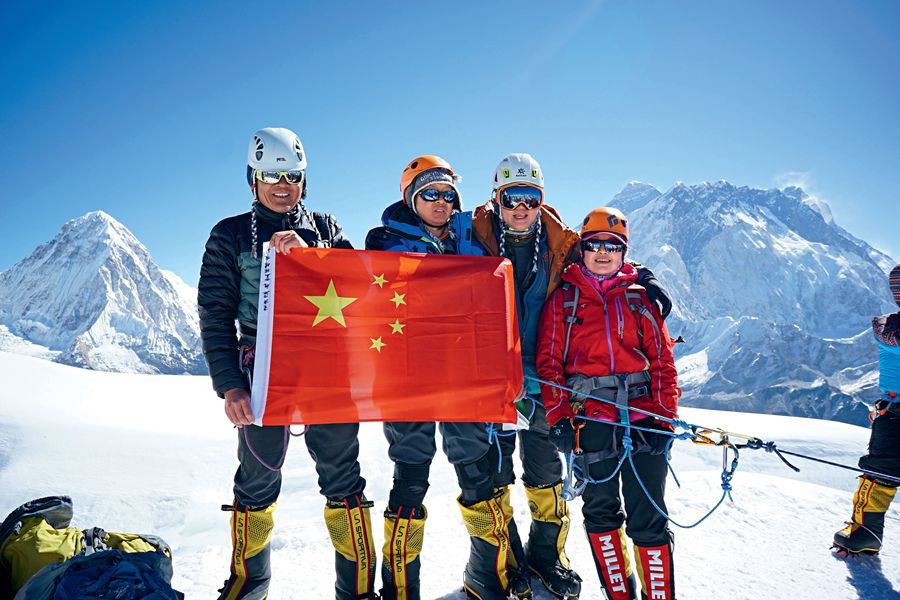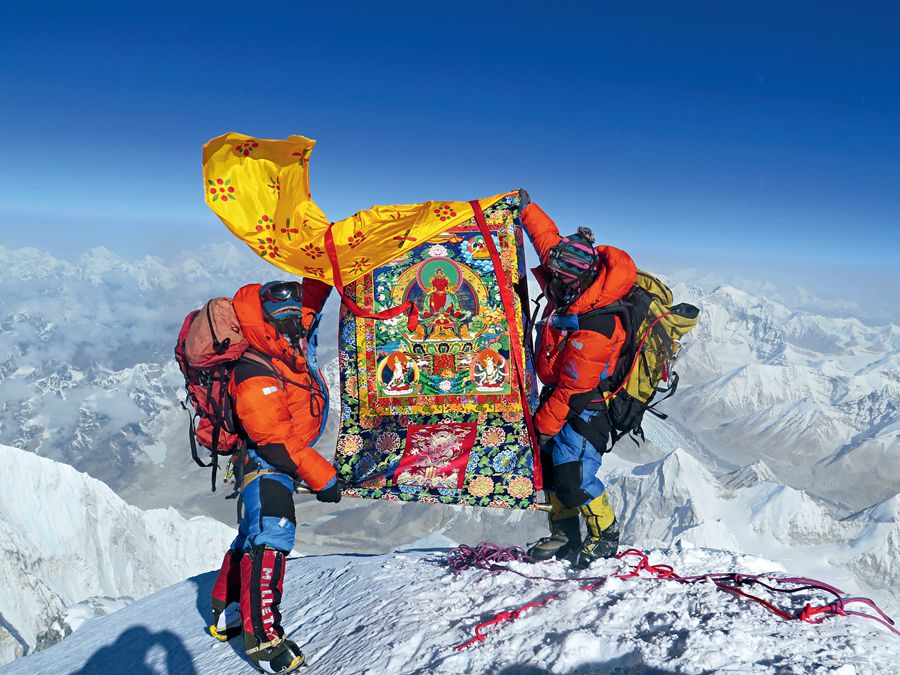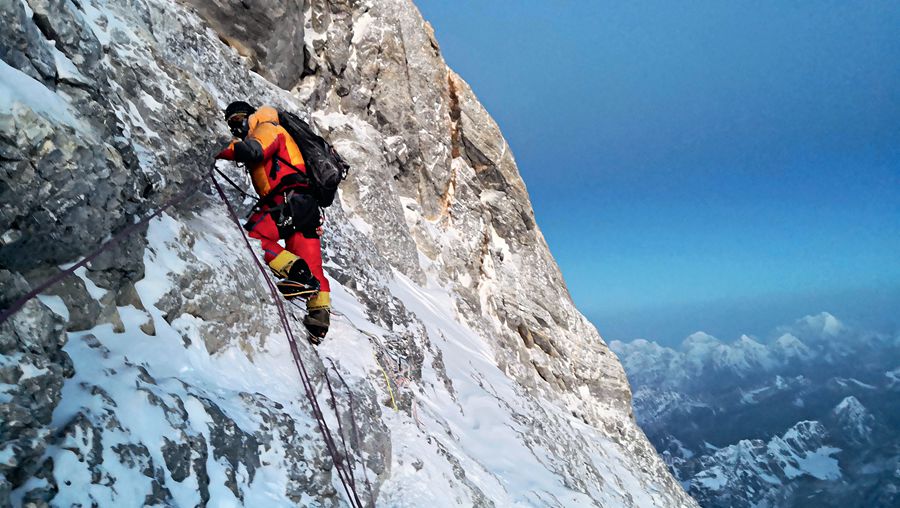WITH the arrival of Mount Qomolangma’s climbing season, climbers from all over the world begin to flood into Kathmandu or Lhasa to start their journey to the base camps on both sides of Mount Qomolangma, the top of the world. There is professional rigor and fineness, brave persistence and patience, as well as touching laughter and tears. As a climber once said, it was all worth it, “climbing to the top of the mountain to see the world.”
Tashi Puncog: Routes Engraved in Memory
Tashi Puncog is compact, lean, and tanned, so it’s hard to imagine the small fellow carrying heavy loads on the road to Mount Qomolangma. However, he has reached the summit of Mount Qomolangma 13 times, among the record holders for number of climbs in China. Whether looking up the peaks at the Qomolangma Base Camp or overlooking the mountains after climbing to the top, the route to the top of the world has long been embedded in his heart.

Climbers march atop the world.
Born in Shelkar Town of Xigaze City, Tashi was among the first group of students of the Tibet Mountaineering School in 1999. In 2004, following graduation, he joined the Tibet Shengshan Mountaineering Expedition Service Co., Ltd., first working as a collaborator for foreign mountaineering teams, and his job was to be in charge of transportation. The means of transportation on the northern slope of Mount Qomolangma consists of three major parts: on vehicles from Lhasa to Qomolangma Base Camp, by yaks from the base camp to the 6,500-meter Advanced Base Camp (ABC), and on foot above 6,500 meters for the last leg of the journey. In 2004, Tashi travelled over 10 times over 6,500 meters in a true testament to his physical and spiritual endurance.
He is one of the few senior guides of the company. In the process of leading teams to the climb, the most frequently asked question is the number of times and experience of climbing Mount Qomolangma. He is also very happy to talk to his team members about mountaineering experience, because he can learn about their physical conditioning, mountaineering experiences, and personalities. The better the understanding of each other, the more tacit action will be, so as to reduce the risk during the climb, and ensure safety to the maximum.

To reach Qomolangma, climbers must have a clear goal of their dream and action plan, and not forget that it will require every ounce of determination to fulfill the goal.
Team members stay at the ABC for most of the time. In addition to high altitude adaptation and outdoor training, they stay in the camp waiting for the most suitable mountaineering weather. Once the chief director issues the mountaineering instructions, mountain guides and team members set off. They spend one night each in the 7,028-meter Camp 1 and the 7,790-meter Camp 2 respectively, and then arrive at the 8,300-meter camp to prepare to reach the summit in the early morning. Among the climbers that reached the summit with Tashi, the shortest time is around four hours, and the longest is 11 hours. Based on years of practical experience, the company has summed up an important climbing rule – the nine-hour duration of reaching the summit of Mount Qomolangma. Tashi believes that this is the golden rule to ensure the safety of climbers.
Reaching the summit of Mount Qomolangma an astounding 13 times has been an amazing achievement, but in fact, he feels that his other record is more satisfying – he has accomplished over 50 climbs above the 8,000-meter mark! This is due to the nature of the work where the most challenging and grueling part of the climb is to lead the teams of climbers to the 8,000-meter mark, beyond which the summit is more of a symbolic achievement for him at this point.
Lu Da: From a Shepherd to a Conservationist
Born at the foot of Mount Qomolangma, Lu Da has a special affection for the highest peak in the world. When he was an adolescent shepherd, the sacred Qomolangma was within sight but beyond reach. Now, he has not only climbed it nine times, but is also the president of the Tibetan Himalayan Alpine Environmental Protection Foundation.
Luda was born in Tingri Town of Xigaze City in 1982. When he was in junior high school, a foreign mountaineering team camped at a spot not far from his home, and hired local yaks to transport mountaineering equipment and other essential items. At that point, he realized that this unreachable mountain could be climbed. The seed of mountain climbing was planted in his heart since then.

Climbers triumphantly hold up a Thangka on the summit of Qomolangma.
In 2002, Lu got his wish fulfilled of studying at the Tibet Mountaineering School. During that period, it was arranged that he would cooperate with the foreign mountaineering team at the Qomolangma Base Camp. In May 2005, when he was collaborating with a mountaineering team from the U.S., he reached the summit of Mount Qomolangma for the first time. Because he didn’t know how to distribute oxygen reasonably and had not yet mastered the rhythm of climbing, his first climb was very difficult. After reaching the summit, he did not see the legendary beautiful lake, but saw more spectacular glaciers and the beauty on the top.
At first, Lu had no idea about environmental protection. But when he noticed the garbage he left at the base camp was collected by a teammate next to him, and saw his teammates even put cigarette butts into bags, he realized that the environmental protection of Mount Qomolangma requires everyone’s participation.
As an alpine guide, he repeatedly tells his team members of the importance of environmental protection and specific measures. First of all, if you don’t have the habit of picking up trash, at least make sure you don’t litter. Secondly, packages of items brought into the mountains should be removed as much as possible.
Mountain guidance and collaboration are not only an important force to ensure the success of climbing Mount Qomolangma, but also a significant contribution to protect the environment. This year, the Tibet Yar-lha Sham-po Expedition Service Co., Ltd. launched an important environmental protection initiative to recover the garbage on the climbing route at 7,028 meters and above at a price of US $15 per kilogram. The company recovered a total of more than 500 kilograms of garbage and shipped them to Lhasa. Tsering Sangdrol, general manager of company, plans to invite some artists to use recycled garbage to create various artworks for exhibition. In this way, not only is waste recycled, but conservation concepts also promoted.

A climber crosses the milestone point of 8,300 meters above sea level.
On April 30, 2018, at the Qomolangma Base Camp at an altitude of 5,200 meters, China’s first alpine environmental protection foundation, the Tibet Himalaya Alpine Environmental Protection Foundation, was established, opening a new chapter in Tibet’s alpine environment protection. Today, Lu has a new title: chairman of the foundation. With the help of the foundation, the company and Shengshan Company cooperated with the Tingri County government to hire local farmers and herders to clean mountaineering garbage in 2018. Lu believes that under the active promotion of the foundation, this action will continue. For him, protecting the environment is to protect his hometown and protect the land on which he lives.
Improved Services and Support
Environmentally friendly toilets, bathhouses, and the supply of semi-cooked food products at 6,500 meters are the highlights of the improved services and support for the Qomolangma climbing activities this year.
This year, the Yar-lha Sham-po Company built two environmentally friendly toilets at the Qomolangma Base Camp for the first time, which are close to the camp and can be moved.
Qomolangma Base Camp had no source of stable electricity, mainly relying on diesel generators for power supply in the past. Since last year, the camps on the north slope of Mount Qomolangma have all been connected to the state grid. The power supply has become more stable, convenient, clean, and the camp has become quieter. Moreover, the company built a bathroom, using an electric heater providing hot water for three users at a time.
The biggest highlight is the distribution of semi-cooked food products at the ABC at an altitude of 6,500 meters. Food is ordered two days in advance. The company has two kitchens in the base camp. Chefs in the kitchen make semi-cooked food at 1 am, which is transported to the camp by the transport team at around 4 am.
Because the incubator mounted on the back of the transport is very similar to the food warmers installed on food delivery e-bikes, every time the transport team members arrive, everyone jokes that “the take-out is coming!” The benefits of this are obvious: first, the freshness, taste, and nutritional value of the food are guaranteed; second, it reduces the amount of domestic garbage and water used in the camp, which is more environmentally friendly. At the same time, in this way, team members can order food according to their personal preferences and receive a more personalized service.
LU MINGWEN is a reporter at the Tibet Business Newspaper.



